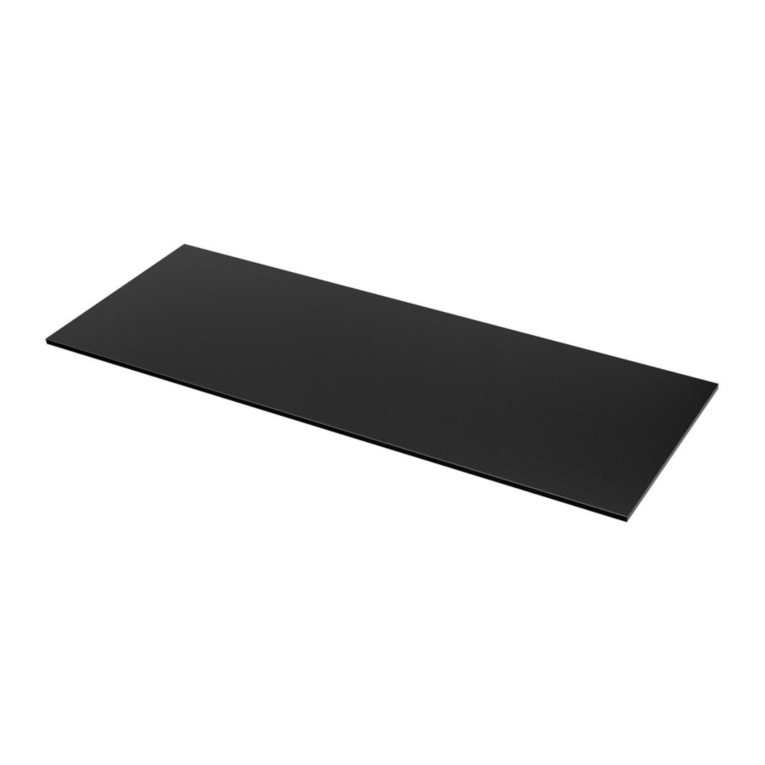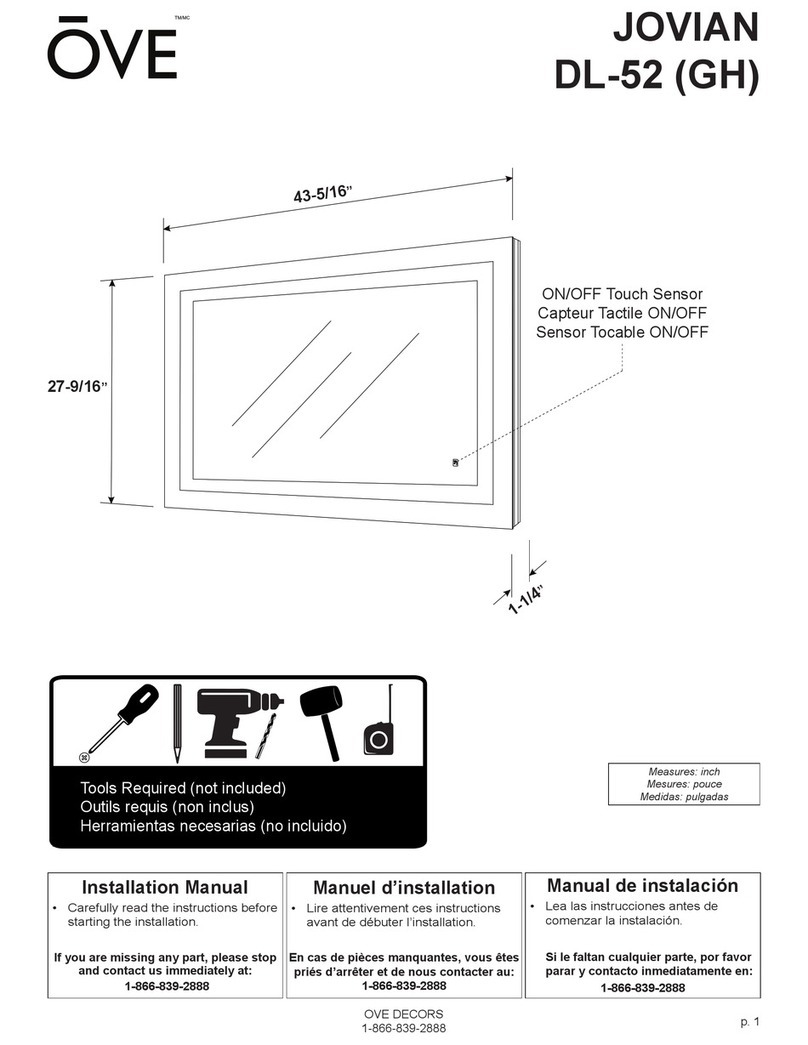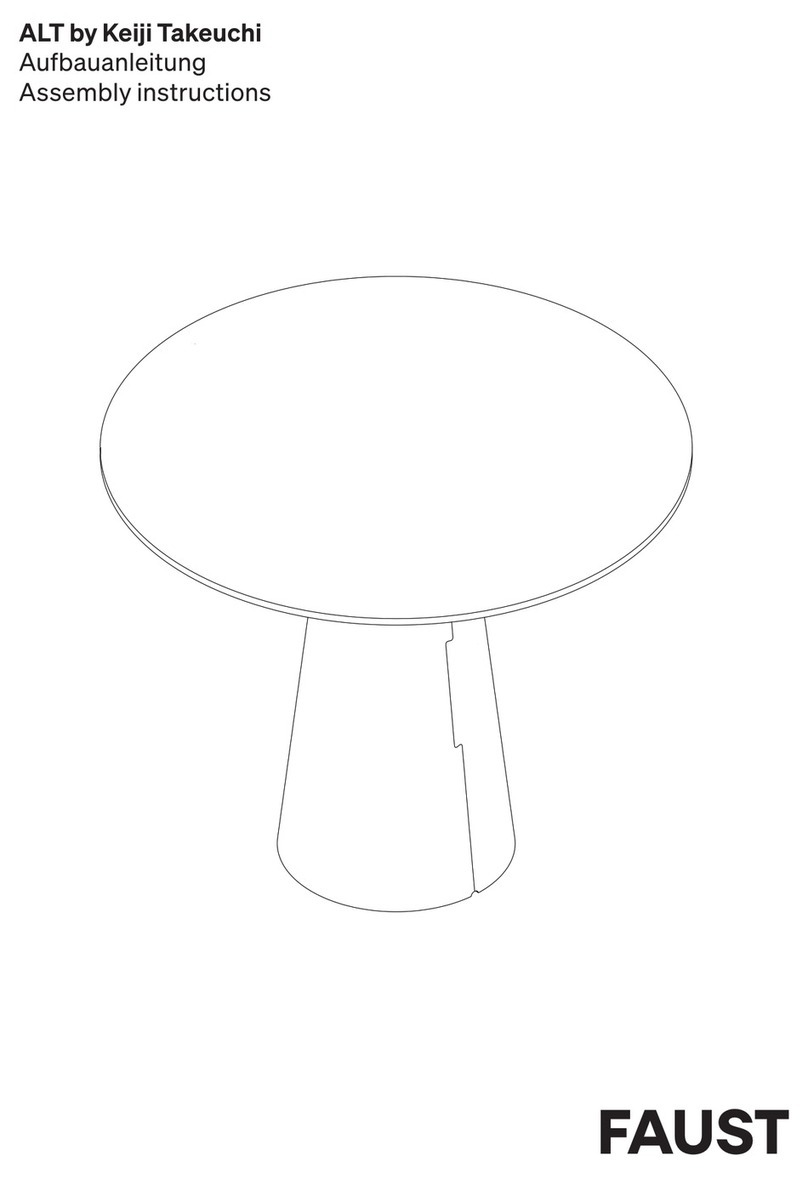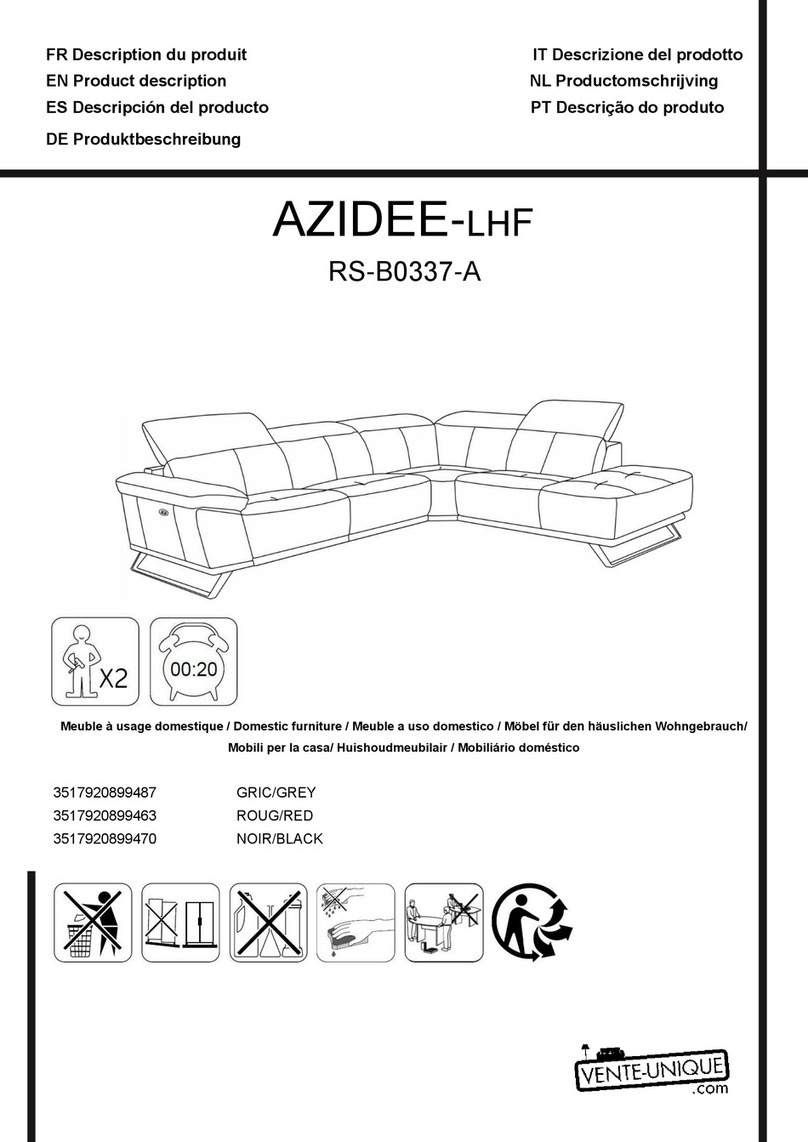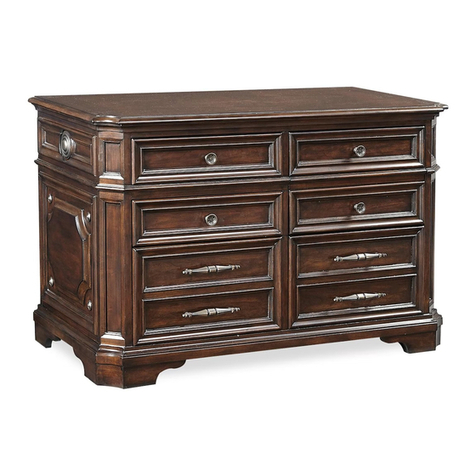Rocker Create-A-Bed User manual

Review full instructions prior to use for important safety information.
Always check Rockler.com to conrm that you are using the most recent version of instructions for your product.
Effective December 2019
Adjustable Queen
Vertical Bed Instructions

2BP1219
GENERAL SAFETY WARNINGS
This product is designed only for specific applications as defined in the instructions and should not be modified or used for any
manner not described in these instructions. Use only recommended accessories. Before using the Adjustable Queen Vertical Bed :
READ, UNDERSTAND and FOLLOW ALL INSTRUCTIONS AND SAFETY WARNINGS. KEEP THESE INSTRUCTIONS READILY
AVAILABLE FOR FUTURE REFERENCE.
> Always confirm that you are using the most recent version of
the Instructions and safety warnings for your product (see the
Instructions link on the product page at Rockler.com).
> Before using another tool with this product, always read,
understand and follow the instructions and safety warnings
in the owner’s manual for that tool. If you do not have the
owner’s manual, obtain one from the tool’s manufacturer
before using it with this product.
> Before using any chemical with this product, always read,
understand and follow all safety warnings and guidelines in
the manufacturer’s Safety Data Sheet (SDS; formerly called
“MSDS”), especially regarding:
• How to safely use the chemical, including potential hazards
and recommended first aid measures;
• Personal safety equipment required to safely use the
chemical (e.g. gloves, eye protection, mask/respirator, etc.);
• Proper and safe handling, storage and disposal of
the chemical.
> Before using this product, review and verify that all tools to be
used with it have safety equipment installed and are in proper
working order as defined by the tool’s owner’s manual.
> Do not use this product until you have read and are
confident you understand:
• Product Specific Safety Warnings (p. 4);
• Elevation Drawings (p. 5);
• Bed Cabinet Materials (p. 6);
• Bed Cabinet Cut List (p. 7);
• Parts List (pp. 8-9);
• Build the Inner Bed Frame (p. 10);
• Install the Pivoting Leg Hardware (pp. 10-11);
• Install the Lower Ball Stud Plates and
Female Pivot Plates (p. 11);
• Attach Head, Foot and Side Rails to Frame (p. 12);
• Attach the Face Panels (pp. 12-13);
• Prep the Bed Cabinet Verticals and Bed Headboard (p. 13);
• Install the Bed Stops on the Bed Cabinet Verticals (p. 13);
• Install the Upper Ball Stud Plates on the
Bed Cabinet Verticals (p. 14);
• Install the Male Pivot Plates on the
Bed Cabinet Verticals (p. 14);
• Build the Top Header Assembly (p. 15);
• Apply Finish Before Installation (p. 15);
• Get Set Up at Installation Site (p. 15);
• Establish Initial Ball Stud Plate Settings (p. 15);
• Install Mattress Support Panels
and Retaining Straps (p. 16);
• Attach the Bed Cabinet Verticals
and the Bed Headboard (p. 16);
• Attach the Top Header Assembly
to the Cabinet Verticals (p. 17);
• Install the Gas Springs (pp. 18);
• Mount the Bed Cabinet to the Wall (pp. 18 - 20);
• Install Mattress and Fine-Tune
Ball Stud Plate Settings (p. 20).
> The user assumes all risk and responsibility for the proper and
safe use of this product and for ensuring product suitability for
the intended application.
> It is the sole responsibility of the purchaser of this product to
ensure that any anyone you allow to use this product reads
and complies with all instructions and safety precautions
outlined in this manual prior to use.
> Follow all standard shop safety practices, including:
• Keep children and bystanders away from the tool
operating area;
• Do NOT use power tools in explosive environments, or in
the presence of flammable liquids, fumes or dust;
• TURN OFF AND UNPLUG all power tools BEFORE
making any adjustments or changing accessories;
• Remain alert and use good judgment. Do not use this
product if you are in any way impaired by medications,
alcohol, drugs or fatigue;
• Keep your work area well lit and clean;
• Dress appropriately. Secure loose clothing, remove all
jewelry and tie up long hair before using this product;
• ALWAYS wear safety glasses, hearing protection
and respiratory protection that complies with
NIOSH/OSHA/ANSI safety standards;
• Use dust collection tools and dust face masks to
reduce exposure to dust;
• Use safety equipment such as featherboards, push
sticks and push blocks, etc., when appropriate;
• Maintain proper footing at all times and do not overreach;
• Do NOT force woodworking tools.
> These warnings and instructions do NOT represent the total
of all information available regarding tool safety, use and
technique. Always seek out opportunities to learn more
and improve your skills and knowledge.
Drilling, sawing, sanding or machining wood
products can expose you to wood dust, a substance known
to the State of California to cause cancer. Avoid inhaling
wood dust or use a dust mask or other safeguards for
personal protection. For more information go to
www.P65Warnings.ca.gov/wood.

3
Danger indicates a hazardous situation that, if not avoided, will result in death or serious injury.
Warning indicates a hazardous situation that, if not avoided, could result in death or serious injury.
Caution indicates a hazardous situation that, if not avoided, may result in minor or moderate injury
or property damage.
Notice indicates important or helpful information and/or user tips.
SAFETY WARNING KEY

4
>Do NOT overtighten the Ball Studs in the Upper Ball
Stud Plates.
> To prevent damage to the pivoting leg assembly,
make sure it is in the closed position when rotating the
Cabinet Verticals and Headboard to the upright position
during assembly.
> Be sure to properly orient the Gas Springs by noting the
location of the labels reading, “Mount this end up.”
PRODUCT SPECIFIC SAFETY WARNINGS
> To avoid serious injury, keep hands and fingers away from the spinning router bit. Maintain
awareness of the bit at all times.
> TO AVOID THE RISK OF SERIOUS INJURY, DO NOT
ALLOW CHILDREN TO PLAY ON THE BED UNIT OR
OPERATE IT WITHOUT ADULT SUPERVISION.
> IN CONSTRUCTING YOUR BED UNIT, DO NOT DEVIATE
FROM THESE INSTRUCTIONS. If you want to make
any modifications, first call 1-877-966-3852. Unapproved
modifications will void your warranty, might cause your bed
unit to not work correctly, and could result in serious injury
during use.
>You MUST have another ADULT help you while installing
your wall bed unit to make sure the bed doesn’t close
inadvertently while you are working. Failure to do so
increases the risk of serious injury.
> The components of this wall bed unit operate with stored
mechanical energy, which can cause serious injury if
mishandled. TO REDUCE THE RISK OF INJURY, THE
BED UNIT MUST BE CORRECTLY AND SECURELY
ANCHORED TO THE WALL, WITH THE CORRECT
FASTENERS FOR THE TYPE OF WALL, AS SPECIFIED
IN THESE INSTRUCTIONS.
> To reduce the risk of seriois injury, do NOT attempt to
lower the bed frame assembly until the bed cabinet has
been securely attached to the wall.
> The placement of fasteners in images in these instructions
is for illustration purposes only. To avoid the risk of serious
injury, you must correctly place and securely attach
fasteners in your wall.
> The Right and Left Side Rails (C and D) MUST be made
with 3/4" plywood (nominal thickness) because of the stress
placed on these parts and the need for greater strength and
structural integrity.
> The Top Header Rear Rail (L) MUST be attached securely
to the Top Header with glue and #8 x 2" Coarse-Thread
Screws. Failure to securely attach the Top Header Rear
Rail to the Top Header increases the chance that the bed
cabinet could detach and tip over, potentially resulting in
serious injury.
> The bed will not stay down without the weight of a mattress.
Operating the bed mechanism without a mattress in place
increases the risk of sudden closing, entrapment and
serious personal injury.
>Do NOT use drywall anchors.
>Do NOT use an impact driver to drive fasteners; the added
torque increases the risk of stripping the pilot holes and
weakening connections. Do NOT overtighten screws.
>Do NOT deviate from the required interior cabinet opening
dimensions listed for the bed size you will be building. An
improperly sized bed cabinet could create a safety hazard
and result in serious personal injury.
>Do NOT construct the cabinet from MDF, particleboard or
melamine-coated MDF or particleboard. The decreased
screw-holding ability of these materials increases the risk
of cabinet joint failure and serious personal injury.
> Mattress dimensions MUST NOT exceed 39" x 75" x 12"
thick, including pillowtop. Mattress MUST NOT weigh less
than 35 lbs. or more than 50 lbs. Do NOT use a foam or
very light mattress with this product.
> Turn off and unplug your router before installing the bit
or adjusting the cutter height.

5
Front View
87"
157⁄8"
657⁄8"
871⁄8"
Elevation Drawings
Side View

6
Bed Cabinet Components
T x W x L Qty.
AInner Frame Strut Piece 3/4" x 11⁄2" x 601⁄2" 10
BInner Frame Side 3/4" x 11⁄2" x 80" 2
CRight Side Rail 3/4" x 57⁄8" x 811⁄2" 1
DLeft Side Rail 3/4" x 57⁄8" x 811⁄2" 1
EHead Rail 3/4" x 57⁄8" x 62" 1
FFoot Rail 3/4" x 3" x 62" 1
GFace Panel 3/4" x 32" x 813⁄4" 2
HBed Headboard 3/4" x 157⁄8" x 643⁄8" 1
T x W x L Qty.
IBed Cabinet Vertical 3/4" x 157⁄8" x 871⁄8" 2
JTop Header 3/4" x 143⁄8" x 643⁄8" 1
KTop Header Front Rail 3/4" x 23⁄4" x 643⁄8" 1
LTop Header Rear Rail 3/4" x 23⁄4" x 643⁄8" 1
MTop Header Mounting Cleat 3/4" x 11⁄2" x 143⁄8" 2
NMattress Support Panel 1/4" x 31" x 80" 2
OLeg Support Rail 3/4" x 3/4" x 601⁄4" 1
M
L
A
A
C
B
N
F
O
G
D
G
I
B
E
N
H
K
M
J
I
> The Right and Left Side Rails (C
and D) MUST be made with 3/4"
plywood (nominal thickness)
because of the stress placed
on these parts and the need
for greater strength and
structural integrity.

7
T x W x L Qty.
3/4" Plywood 3/4" x 4' x 8' 4
1/4" Plywood 1/4" x 4' x 8' 2
6' Hardwood 1" x 2" x 6' 11
8' Hardwood 1" x 2" x 8’ 2
Bed Cabinet Cut List
N N
J
H
II
GG
E
K
F
L
C
D
6' Hardwood
6' Hardwood - Must match species of plywood
8' Hardwood
3/4" Plywood
3/4" Plywood
1/4" Plywood
3/4" Plywood
1/4" Plywood
8' Hardwood
3/4" Plywood
M
A A
A A
A A
B B
O

8
Bed Cabinet Parts List
Qty.
11 Male Pivot Plate 2
12 Plastic Pivot Plate Spacer 2
13 E-Clip 2
14 #12 x 3/4" Silver Screw 12
15 Upper Ball Stud Plate 2
16 Ball Stud 2
17 Ball Stud Spacer 2
18 Gas Spring 2
19 Bed Stop 2
20 Mattress Retaining Strap 2
Qty.
1Right Metal Pivoting Leg 1
2Left Metal Pivoting Leg 1
3#10 x 3/4" Black Screw 6
4T-Nut 16
5Machine Screw 16
61/4" x 2" Hex-drive Leg
Support Rail Screw 2
7Right Lower Ball Stud Plate 1
8Left Lower Ball Stud Plate 1
9#10 x 15⁄8" Screw 4
10 Female Pivot Plate 2
2
8
19
12
13
11
10
9
6
16
17
15
18

9
Other Required Materials
Qty.
Veneer Edge Banding 13/16" x 80'
Wood Glue 8 oz. bottle
3d x 11⁄4" Finish Nails 1 box
4d x 11⁄2" Finish Nails 1 box
Qty.
6d x 2" Finish Nails 1 box
#8 x 11⁄4" Coarse-thread Screws 100
#8 x 11⁄2" Coarse-thread Screws 30
#8 x 2" Coarse-thread Screws 40
Required Tools
• Handheld power drill
• 1/8" diameter drill bit
• 3/16" diameter drill bit
• 1/4" diameter drill bit
• 5/16" diameter drill bit
• 5/8" Forstner bit
• 3/4" Forstner bit
• 1" Forstner bit
• Power saw, table saw or circular saw
• Jigsaw or coping saw
• Phillips-head and flathead
screwdrivers or driver bits for drill
• Tape measure
• #4 hex wrench
• Hammer
• Chisel
• Clamps
• Straightedge or framing square
• Household iron (for veneer tape)
• Utility knife
• 7/16" socket, wrench or driver
• 1/2" wrench
• Stud finder
20
7
1
15
16
17
3
14
5
4
18
11 10

10
Build the Inner Bed Frame
1. Cut the Inner Frame Strut Pieces (A) to size and organize
them into pairs.
2. For each pair, lay one piece flat on its face and the other
on its long edge. Apply wood glue to the inside edge of
the piece lying flat; then bring the pieces together to form
an “L” shape and make sure the ends are flush. Drill and
countersink 1/8" pilot holes about 8" apart and join the
pieces with #8 x 11⁄2" coarse-thread screws. Make five
Frame Strut assemblies.
3. Position the Frame Strut assemblies between the Inner
Frame Sides (B) and space them 20" apart. Fig. 1. Drill and
countersink 1/8" pilot holes through the Inner Frame Sides
into each end of the Frame Strut assemblies and attach with
#8 x 2" coarse-thread screws. Drive the screws so the heads
are flush with the surface.
Install the Pivoting Leg Hardware
1. Cut the Side Rails (C) to size. Mark the radius on the top
front edges of both Side Rails, as well as the locations of the
5/8" holes on the Side Rails’ inside faces. Shop Drawing.
2. Cut the rounded corners with a jigsaw and sand smooth.
Apply veneer edge banding along the top edges and rounded
ends of the Side Rails (C). Also apply edge banding to
the top edges of the Head Rail (D) and the Foot Rail (E).
Trim excess.
3. Drill the 5/8" diameter holes 1/2" deep on the inside faces
of the Side Rails (C). Fig. 2.
4. Position the Right Metal Pivoting Leg (1) in place on inside
face of the Right Side Rail (C), inserting the pivot in the hole
you just drilled. Make sure the pivot plate is square to the
edges of the Side Rail; then mark the locations of the
bottom two screw holes.
5. Remove the Right Metal Pivoting Leg (1) and drill 1/4"
diameter through holes at the two locations you just marked,
using a backer board to avoid tear-out.
6. From the outside face of the Right Side Rail (C), insert two
T-Nuts (4) in the two 1/4" holes. Align the holes in the plate
of the Right Metal Pivoting Leg (1) with the holes in the Side
Rail and secure with Machine Screws (5) threaded into the
T-Nuts. Drive #10 x 3/4" Black Screws (3) in the remaining
holes in each plate. Fig. 2.
Fig. 1
20"
20"
B
A
A
A
A
B
B
A
A
A
A
A
A
A
A
A
A

11
7. Repeat Steps 4-6 for the Left Metal Pivoting Leg (2) and
Left Side Rail (C).
8. Locate the center on each end of the solid-wood Leg Support
Rail (O) by drawing diagonal lines from corner to corner.
Drill a 1/4" diameter hole 11 ⁄2" deep centered on the “X”
at each end. Don’t attach the rail to the Metal Pivoting
Legs (1 and 2) at this time; wait until the piece has
been finished.
9. Remove the Right and Left Metal Pivoting Legs (1 and 2)
to allow easy finishing of the Side Rails (C and D).
Install the Lower Ball Stud Plates
and Female Pivot Plates
1. Mark and drill 1" diameter through holes for the Female
Pivot Plates (10) toward the back of the Right and Left Side
Rails (C and D) at the location specified on the Shop
Drawing. Use a backer board to avoid tear-out.
2. Position the Right Lower Ball Stud Plate (7) on the Right
Side Rail (C) so that the channel rests on top of the rail, with
the plate on the outside and the hex adjustment head
facing the front end of the rail. Align the back edge of the
Right Adjustable Lower Plate with the back end of the Side
Rail and mark the front two hole locations. Fig. 3.
3. Drill 1/4" diameter through holes at the two marked
locations. Insert two T-Nuts (4) into the holes from the
inside face of the Right Side Rail (C). Attach the Right
Lower Ball Stud Plate (7) to the Right Side Rail with two
Machine Screws (5) threaded through the Plate into
the T-Nuts. Fig. 3.
4. Repeat Steps 3 and 4 to mount the Left Lower Ball Stud
Plate (8) on the Left Side Rail (D).
5. On the inside of each Side Rail (C and D), position a Female
Pivot Plate (10) with the pivot in the 1" through hole. Use a
square to align the plate; then mark screw locations. Drill
stopped pilot holes and attach each Female Pivot Plate
with four #12 x 3/4" Silver Screws (14). Fig. 4.
Fig. 2 Fig. 4
Fig. 3
C
21⁄2"
5/8" diameter x
1/2" deep
1/4" diameter
31⁄8"
5
3
1
3
4
Flush with back edge
of Right Side Rail (C)
C
Inside
face
8
C
Inside face
10
14
14
8
4
5

12
Attach Head, Foot and Side Rails to Frame
1. Position the Foot Rail (F) against the foot end of the inner
frame, making sure that the bottom edges are aligned and
that the ends of the Foot Rail are flush with the Inner
Frame Sides (B). Fig. 5.
2. Drill five evenly spaced 1/8" pilot holes 11⁄4" deep through
the Inner Frame Strut (A) and into the inside face of the Foot
Rail (F), being careful not to drill all the way through. Attach
the pieces with #8 x 11⁄4" Coarse-Thread Screws.
3. Repeat Steps 1 and 2 for the Head Rail (E).
4. Position the Left and Right Side Rails (C and D) against the
Inner Frame Sides (B) so that the Female Pivot Plates (10)
are on the inside. Make sure that the front, back and bottom
edges of the Side Rails are flush with the frame. From the
inside, drill eight 1/8" pilot holes (two between each Frame
Strut) 11⁄4" deep through the frame and into each Side Rail.
Attach the pieces with 11⁄4" Coarse-Thread Screws. Fig. 5.
5. Drill two 1/8" diameter pilot holes through the outside face
of each Side Rail (C and D) into the Foot Rail (F). Attach by
driving #8 x 2" Coarse-Thread Screws flush to the surface.
Fig. 5.
6. Use the two unused screw holes toward the back of the
Right and Left Lower Ball Stud Plates (7 and 8) as a guide
to drill 1/8" diameter pilot holes through each Side Rail (C
and D) into the Head Rail (E). Also drill a third 1/8"
diameter pilot hole toward the bottom of each Side
Rail into the Head Rail.
7. Attach the Side Rails (C and D) to the Head Rail (E) by
driving the included #10 x 15⁄8" Screws (9) into the open
screw holes in the Right and Left Lower Ball Stud Plates (7
and 8). Drive a #8 x 2" Coarse-Thread Screw into the
bottom pilot hole in each rail until flush.
Attach the Face Panels
1. Choose the best face for each Bed Face Panel (G) and
position the panels next to each other on a non-marring
surface with those faces down. Apply veneer edge banding
to the outside edges and to the edges that will show at the
foot of the bed. Trim excess. Fig. 5.
2. Measure 1/4" in from the long edges and draw a line the
full length on each side.
3. Lay the bed frame assembly on the Bed Face Panels (G) so
that the front of the Foot Rail (F) is flush with the veneered
ends of the Bed Face Panels and the Side Rails (C and D)
are aligned with the lines you drew in Step 2.
Fig. 5
1/4"
G
G
F
C
B
10
7
E
8
D
To ensure that the bed is square, the Bed
Face Panels (G) MUST be aligned next to each other, and
the Foot Rail (F) MUST be flush with the ends of the Bed
Face Panels.

13
4. To show where to apply glue, trace pencil lines along the
inside of the Inner Frame Struts (A) and Sides (B).
5. Remove the bed frame assembly and apply glue to the Bed
Face Panels (G) inside the trace lines you drew in Step 4.
6. Reposition the bed frame assembly on the Bed Face
Panels (G), again making sure that the front of the Foot
Rail (F) is flush with the veneered ends of the Bed Face
Panels and that the Side Rails (C and D) are aligned with
the lines you drew in Step 2.
7. Maintaining alignment, drill 1/8" pilot hole through the
Inner Frame Struts (A) and into the Bed Face Panels (G)
at the two locations marked “X”, taking care not to drill
all the way through the panels. Secure with a #8 x 11⁄4"
Coarse-Thread Screw at each “X” location. Fig. 6.
8. Maintaining flush edges, drill another 1/8" pilot hole through
the Inner Frame Struts (A) and into the Bed Face Panels (G)
at the two locations marked “Y”. Secure with a #8 x 11⁄4"
Coarse-Thread Screw at each “Y” location. Fig. 6.
9. Make sure the Side Rails (C and D) are aligned with
the line 1/4" in from the outside edges of the Bed Face
Panels (G). If they aren’t, hold them in line and then drill
a 1/8" pilot hole at the locations marked “Z” and secure
with #8 x 11⁄4" Coarse-Thread Screws. Check for square
again. An out-of-square assembly will cause major problems
in future steps. Fig. 6.
10. Once the assembly is squared, drill 1/8" pilot holes every
6" through the remaining Inner Frame Struts (A) and into
the Bed Face Panels (G) and secure with #8 x 11⁄4" Coarse
Thread Screws. Wipe away any excess glue.
Prep the Bed Cabinet
Verticals and Bed Headboard
1. Apply veneer edge banding to the front edges of both Bed
Cabinet Verticals (I) and to the top and bottom edges of
the Bed Headboard (H). Trim excess.
2. If you are cutting notches in the back edges of the Bed
Cabinet Verticals (I) to accommodate base molding at
the installation site, mark and cut those notches.
Install the Bed Stops
on the Bed Cabinet Verticals
1. Make a mark 73⁄8" in from the front edge and 6" down
from the top edge on the inside face of each Bed
Cabinet Vertical (I). Fig. 7.
2. Drill a 5/16" diameter hole 1/2" deep centered on
these marks.
3. On each side, insert the pin on the Bed Stop (19) into that
hole, line up the Bed Stop so that the flat is parallel to the
front edge of the Bed Cabinet Vertical (I) and attach the
Bed Stop with a #10 x 3/4" Black Screw (3). Fig. 7 - Top Edge of Bed Cabinet Verticals (I)
Fig. 6
X
YY
X
Z
Z
6"
5/16" diameter
1/2" deep
73⁄8"
I
Top edge of Bed
Cabinet Verticals (I)
Inside
face
Front
edge
The edges of the Bed Face Panels (G)
MUST extend 1/4" past the edges of the assembled bed
frame on the long sides. The ends of the Bed Face Panels
might extend 1/4" beyond the Head Rail (E).

14
Install the Upper Ball Stud Plates
on the Bed Cabinet Verticals
1. On the inside face of each Bed Cabinet Vertical (I), make
a vertical mark 10" in from the front edge. Make additional
horizontal marks 291⁄8" and 325⁄8" up from the bottom edge.
Fig. 8.
2. Install a 3/4" straight bit in a plunge router that’s equipped
with an edge guide, or use a straightedge clamped to the
Bed Cabinet Vertical (I). Set the bit cutting depth to 1/4",
and set the edge guide or the straightedge so that the
center of the bit will be 10" from the front edge of the
Bed Cabinet Vertical (I). In other words, the bit should
be centered on the vertical mark you made in Step 1.
3. In each Bed Cabinet Vertical (I), carefully rout a
3/4" wide x 1/4" deep mortise between the horizontal
lines you marked in Step 1. Make sure to keep the router
tight against the guide and start and stop the mortise at the
inside edges of the lines while routing the mortise.
4. Insert an Upper Ball Stud Plate (15) in each mortise and use
the two mounting holes in the Upper Plate to mark drilling
locations. Remove the Upper Ball Stud Plate and drill 1/4"
diameter through holes at the marked locations, using a
backer board under the Bed Cabinet Verticals (I) to
prevent tear-out.
5. Place an Upper Ball Stud Plate (15) back in each mortise.
Insert a T-Nut (4) in each hole on the outside face of the
Bed Cabinet Verticals (I) and thread Machine Screws (5)
through the mounting holes in the Upper Ball Stud Plates
and into the T-Nuts. Tighten securely.
Install the Male Pivot Plates
on the Bed Cabinet Verticals
1. Make a mark 43⁄4" in from the front edge and 113⁄4" up from
the bottom edge on the inside face of each Bed Cabinet
Vertical (I). Fig. 8.
2. Drill a 5/8" diameter hole 1/2" deep centered at each
of these marks.
3. To mount each Male Pivot Plate (11), insert the short (back)
end of the pivot rod into the hole and use a square to align
the plate. Mark the locations of the upper two screw holes
and remove the Male Pivot Plate.
4. Drill 1/4" through holes at these locations, using a backer
board to avoid tear-out. Fig. 8.
5. From the outside face, insert two T-nuts (4) in the holes.
6. Realign each Male Pivot Plate (11) with the holes and secure
with Machine Screws (5) threaded into the T-nuts (4). Drill
pilot holes and drive #12 x 3/4" Silver Screws (14) into the
plate’s remaining two holes.
Fig. 8 - Bottom Edge of Bed Cabinet Verticals (I)
Turn off and unplug your router before
installing the bit or adjusting the cutter height.
The Ball Studs (16) and Ball Stud
Spacers (17) are not installed on the Upper Ball Stud
Plates (15) at this point.
Cut notches
to accommodate
base molding
if necessary
10"
325⁄8"
291⁄8"
43⁄4"
113⁄4"
I
5/8" diameter
1/2" deep
1/4" diameter
Bottom edge of Bed
Cabinet Verticals (I) Front
edge
1/4" through hole

15
Build the Top Header Assembly
1. Apply Veneer Edge Banding to the bottom edges of the
Top Header Front Rail (K) and Top Header Rear Rail (L).
Trim excess. Fig. 9.
2. Use 1/2" deep spacer blocks to raise the Top Header (J)
off the work surface. This will provide the necessary 1/2"
overhang of the Top Header Front and Rear Rails (K and L).
3. Run a bead of glue along the front edge of the Top
Header (J). Position the Top Header Front Rail (K) so
that its ends are flush with the ends of the Top Header.
4. Attach the Top Header Front Rail (K) with 2" Finish
Nails. Fig. 9.
5. Run a bead of glue along the back edge of the Top
Header (J). Position the Top Header Rear Rail (L) so
that its ends are flush with the ends of the Top Header.
The Top Header Rear Rail (L) MUST be
attached securely to the Top Header with glue and #8 x 2"
Coarse-Thread Screws. Failure to securely attach the Top
Header Rear Rail to the Top Header increases the chance
that the bed cabinet could detach and tip over, potentially
resulting in serious injury.
6. Drill pilot holes through the Top Header Rear Rail (L)
into the Top Header (J). Attach with #8 x 2" Coarse-Thread
Screws. Fig. 9.
7. Position both solid-wood Top Header Mounting Cleats (M)
between the Top Header Front and Rear Rails (K and L) on
top of and flush with the ends of the Top Header (J). Drill
four evenly spaced countersunk 1/8" diameter pilot holes
through the top edge of the Mounting Cleats and into
the Top Header. Take care not to drill all the way through
the Top Header.
8. Apply glue to the bottom edges of the Top Header Mounting
Cleats (M); then place them in position and secure them to
the Top Header (J) with #8 x 2" Coarse-Thread Screws.
Fig. 9.
Apply Finish Before Installation
1. Remove all hardware from the wooden components to
make finishing easier.
2. Fill all nails holes and sand all components.
3. Apply finish of choice to visible areas of all pieces,
including moldings.
Get Set Up at Installation Site
1. After the wooden bed parts have been finished, reinstall
all hardware except for the Bed Stops (19) and the Metal
Pivoting Legs (1 and 2).
2. Position the assembly on the floor where you plan to install
the bed, first placing a blanket, rug or other padding under
the Face Panel (G) surface to protect it from scratching.
Establish Initial Ball Stud Plate Settings
Do NOT overtighten the Ball Studs in the
Upper Ball Stud Plates.
These are initial settings to provide
maximum lifting power in beds constructed with 3/4" thick
plywood material. They can be adjusted, if necessary, later.
1. Use a 7/16" socket or other wrench to adjust the two Lower
Ball Stud Plates (7 and 8) until the ball stud of each is at
position 5. Fig. 10.
2. In each of the two Upper Ball Stud Plates (15), thread a
Ball Stud (16) through a Ball Stud Spacer (17) and into
position 3 in the Upper Ball Stud Plates. Tighten until
snug. Do not overtighten. Fig. 10.
Fig. 9
Fig. 10
2" Finish Nail
#8 x 2"
Coarse-Thread
Screws
1/2"
K
M
L
J
L K
M
J
8
15
17
16

16
Install Mattress Support Panels
and Retaining Straps
1. With the help of another adult, if necessary, turn the bed
frame assembly over or position it upright and install the
desired cabinet pulls on the outside of the Bed Face
Panels (G). For optimal leverage, cabinet pulls should be
located between 5' and 6' from the bottom of the Bed
Face Panels.
2. Reposition the bed frame assembly so the Bed Face
Panels (G) are facedown on a blanket or other nonmarring
surface. Position the Mattress Support Panels (N) side by
side on top of the slats of the inner bed frame. Fig. 11.
3. Drill pilot holes and attach with eight #8 x 11⁄4"
Coarse-Thread Screws per panel. Do not use glue.
4. From each of the front corners, measure out 16" in both
directions and make marks near the edges of the Mattress
Support Panels (N), directly over the inner frame.
5. At each mark, attach one end of a Mattress Retaining
Strap (20) with a #8 x 11⁄4" Coarse Thread Screw.
6. Reinstall the Metal Pivoting Legs (1 and 2) and Leg
Support Rail (O).
Attach the Bed Cabinet Verticals
and the Bed Headboard
1. Position the Bed Cabinet Verticals (I) on their front
edges, next to the corresponding side of the bed frame
assembly. Fig. 11.
2. Slide a Plastic Pivot Plate Spacer (12) on the bar of the Male
Pivot Plate (11) on each Bed Cabinet Vertical (I).
3. Position the Bed Cabinet Verticals (I) so that the pivot bars
go in the pivot holes in the assembled bed frame. The ends
of the pivot bars should protrude through the pivot holes
on the inside of the bed frame.
4. Snap the provided “E” Clips (13) in the grooves of the
pivot bars.
5. From the back bottom edge of each Cabinet Vertical (I),
measure up 15" and make a mark. Do the same at
18" and 28". Fig. 12.
6. Position the Bed Headboard (H) between the Cabinet
Verticals (I) with its bottom edge at the 15" marks and
hold or clamp in place. Fig. 12.
7. Drill pilot holes through each Cabinet Vertical (I) into
the Bed Headboard (H) at the 18" and 28" marks. Fig. 12.
8. Secure the Bed Headboard to the Cabinet Verticals with
#8 x 2" Coarse-Thread Screws.
N
I
20
I
12
13
10
11
13
12
20
Fig. 11

17
Attach the Top Header Assembly
to the Cabinet Verticals
1. With the bed frame assembly still on the floor with the
Face Panel (G) surface facing down and the pivoting
leg in the closed position, carefully rotate the Cabinet
Verticals (I) and Bed Headboard (H) upright.
2. Position the Top Header assembly (J,K, L and M) between
the Cabinet Verticals (I), making sure that the Top Header
Rear Rail (L) is at the back. Align everything so that the top
edges of the assembly are flush with the top edges of the
Cabinet Verticals and hold or clamp in place. Fig. 13.
3. Working from above the cabinet, drill four evenly spaced
pilot holes for #8 x 11⁄4" Coarse-Thread Screws through
the solid-wood Top Header Mounting Cleats (M) into the
Cabinet Verticals (I) at each end of the Top Header (J),
taking care not to drill all the way through the
Cabinet Verticals. Fig. 13.
4. Attach the Top Header assembly at each end with four
#8 x 11⁄4" Coarse-Thread Screws driven through the Top
Header Mounting Cleats (M) into the Cabinet Verticals (I).
Clamps can be used to hold the Top
Header assembly between the Cabinet Verticals, making
attachment easier.
Fig. 13
Fig. 12
H
15"
18"
28"
I
> To prevent damage to the pivoting leg assembly,
make sure it is in the closed position when rotating
the Cabinet Verticals and Headboard to the upright
position during assembly.
J
K
M
ML
#8 x 11⁄4" Coarse-Thread Screws

18
Install the Gas Springs
2. With an adult helper holding the bed cabinet, lift the front
of the bed frame so it pivots up into the cabinet. Go at least
3" beyond flush at the top. Fig. 14.
1. With the cabinet assembly upright and the bed frame down,
position the bed cabinet 2-3' from the wall where it will be
installed (to give you enough room to work behind it).
3. Install a Gas Spring (18) on each side by snapping one
end onto the Lower Ball Stud Plate (7 and 8) on the Bed
Side Rail (C and D) and the other end on the Upper Ball
Stud Plate (15) on the Cabinet Vertical (I). Fig. 14.
4. With your adult helper securely holding the bed cabinet
and you working from behind the cabinet, push the top
of the bed out 4" or 5" and reattach the Bed Stops (19).
5. Working with your helper, carefully let the bed frame
return to the vertical position.
Mount the Bed Cabinet to the Wall
1. Make sure the cabinet will be able to sit flush
against the wall.
2. Position the cabinet against the wall. Center the bed frame
in the cabinet opening by placing a folded piece of cardboard
between the bed frame and the Cabinet Vertical (I) on each
side near the top.
Be sure to properly orient the Gas
Springs (18) by noting the location of the labels reading,
“Mount this end up.”
THESE WARNINGS PERTAIN
TO ALL REMAINING STEPS:
> The components of this wall bed unit operate with
stored mechanical energy, which can cause serious
injury if mishandled. TO REDUCE THE RISK OF
INJURY, THE BED UNIT MUST BE CORRECTLY
AND SECURELY ANCHORED TO THE WALL,
WITH THE CORRECT FASTENERS FOR
THE TYPE OF WALL, AS SPECIFIED
IN THESE INSTRUCTIONS.
> Once the Gas Springs (18) are installed, the bed
will not stay down without the weight of a mattress.
Operating the bed mechanism without a mattress
in place increases the risk of sudden closing,
entrapment and serious personal injury.
> The components of this wall bed unit operate with
stored mechanical energy, which can cause serious
injury if mishandled. TO REDUCE THE RISK OF
INJURY, THE BED UNIT MUST BE CORRECTLY
AND SECURELY ANCHORED TO THE WALL,
WITH THE CORRECT FASTENERS FOR
THE TYPE OF WALL, AS SPECIFIED
IN THESE INSTRUCTIONS.
>You MUST have another ADULT help you while
installing your wall bed unit to make sure the bed
doesn’t close inadvertently while you are working.
Failure to do so increases the risk of serious injury.
Fig. 14
At least 3"
15
18
7
To reduce the risk of seriois injury, do
NOT attempt to lower the bed frame assembly until the bed
cabinet has been securely attached to the wall.

19
A. Use a stud finder to locate and mark the centers of
at least four studs. Fig. 15.
B. Drill 1/4" holes through the Top Header Rear Rail (L)
and into the wall at these locations.
C. With an adult helper, move the bed cabinet away
from the wall.
D. Use a 9/16" drill bit to widen and extend the pilot
holes, being sure to drill through the metal studs.
E. Insert toggle bolt screws in the holes in the Top Header
Rear Rail (L) and thread on the toggle wings.
F. Reposition the bed cabinet against the wall, carefully
inserting the toggle bolts into the pilot holes and
push the bolts in. Fig. 17.
G. Tighten the toggle bolts until the cabinet is
secure to the wall.
A. Use a stud finder to locate and mark the centers of
at least four wall studs. Fig. 15.
B. Drill 3/16" pilot holes through the Top Header Rear
Rail (L) at these locations.
C. Attach securely with four 1/4" x 3" lag screws. Fig. 16.
For walls with metal studs:
3. Securely attach the bed cabinet to the wall using one of
the following methods. You will need to use at least four
fasteners to secure the cabinet.
For walls with wood studs:
You MUST attach the bed cabinet
assembly to the wall by driving at least four 1/4" x 3" lag
screws through the Top Header Rear Rail (L) into 2 x 4
or larger wooden wall studs. Failure to secure the unit into
wooden wall studs increases the chance that the bed
cabinet will detach and tip over, potentially resulting
in serious injury.
Do NOT use an impact driver to drive fasteners; the added
torque increases the risk of stripping the pilot holes and
weakening connections. Do NOT overtighten screws.
You MUST attach the bed cabinet
assembly to the wall with at least four 3/16" x 4" toggle
bolts secured through the Top Header Rear Rail (L) into
metal studs. Failure to secure the unit properly increases
the chance that the bed cabinet will detach and tip over,
potentially resulting in serious injury.
Fig. 15
Fig. 16 - Wall with Wood Studs
Fig. 17 - Wall with Metal Studs
Outer Edge
of Stud
Outer Edge
of Stud
Centerline
Wall
1/4" x 3"
Lag Screw
Wood Stud
L
J
Wall
3/16" x 4"
Toggle Bolt
Metal Stud
L
J

20 Distributed by Rockler Companies, Inc.
4365 Willow Dr. Medina, MN 55340
62206
Rev 12/19
1-800-279-4441
www.rockler.com
For concrete, mortar or brick walls:
A. Drill four evenly spaced 3/16" through holes in the
Top Header Rear Rail (L).
B. With a 4" long 5/32" diameter concrete drill bit, use
the through holes in the Rear Header Rail (L) to drill
pilot holes 2" into the wall.
C. Attach securely with 3/16" x 21⁄4" masonry screws.
Fig. 18.
4. If the gap between the bed frame and the Cabinet Verticals
is uneven, push or gently kick the Cabinet Vertical at the
bottom on the side with the smallest gap at the top.
Install Mattress and Fine-Tune
Ball Stud Plate Settings
1. With the help of another adult, rotate the bed frame out
of the cabinet, unfold the leg assembly and lower the
bed frame to the floor, making sure to maintain
downward pressure.
2. While the helper continues to hold the bed frame down,
place the mattress on the frame and secure it with the
Mattress Retaining Straps (20).
3. If lowering the bed frame seems too difficult, or if the bed
frame starts to lift even with the mattress in place, the setting
on the Lower Ball Stud Plates could be too high, resulting in
too much lifting power.
To decrease the lifting power, use a socket wrench or
driver to turn the hex head on the Lower Ball Stud
Plates (7 and 8) to the right, moving the ball stud to a lower
setting. Be sure to make identical adjustments to both
Lower Ball Stud Plates. And make adjustments in small
increments. Even small adjustments can make a big
difference in the bed’s lifting power. Fig. 19.
If the bed frame sticks out beyond the front of the cabinet
when the bed is in the closed position, you will need to make
a similar adjustment, turning the hex head on the Lower Ball
Stud Plates (7 and 8) to the right to move the ball stud to a lower
setting. Again, make small, identical adjustments to both Lower
Ball Stud Plates to “sneak up” on the right setting. Do NOT force
the bed frame closed without making the adjustment; if you do,
you will damage the head of the gas spring.
>You MUST have another ADULT help you while installing
your wall bed unit to make sure the bed doesn’t close
inadvertently while you are working. Failure to do so
increases the risk of serious injury.
> Once the Gas Springs (18) are installed, the bed will not
stay down without the weight of a mattress. Operating
the bed mechanism without a mattress in place increases
the risk of sudden closing, entrapment and serious
personal injury.
> Mattress dimensions MUST NOT exceed 60" x 80" x 12"
thick, including pillowtop. Mattress MUST NOT weigh less
than 65 lbs. or more than 80 lbs. Do NOT use a foam
or very light mattress with this product.
You MUST attach the bed cabinet
assembly to the wall by driving at least four 3/16" x 21⁄4"
masonry screws through the Top Header Rear Rail (L)
into the wall. Failure to secure the unit properly increases
the chance that the bed cabinet will detach and tip over,
potentially resulting in serious injury.
Check Rockler.com for updates. If you have further questions, please
contact our Technical Support Department at 1-800-260-9663
or support@rockler.com
Fig. 19 - Mattress Removed for Clarity
Fig. 18 - Concrete, Brick or Mortar Walls
Wall
3/16" x 21⁄4"
Masonry Screw
Concrete Wall
L
J
Hex Head
Adjustment
Table of contents
Other Rocker Indoor Furnishing manuals
Popular Indoor Furnishing manuals by other brands

DITALIA
DITALIA CD-232 Assembly instructions
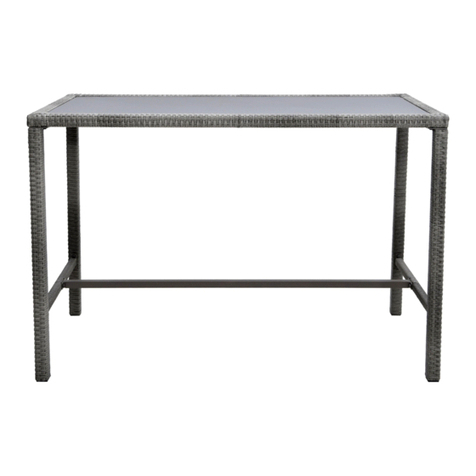
Marquee
Marquee BAYFIELD STEEL WICKER BAR TABLE 0177371 Assembly instructions

New Classic Furniture
New Classic Furniture ORION U1769-30P2 Assembly instructions
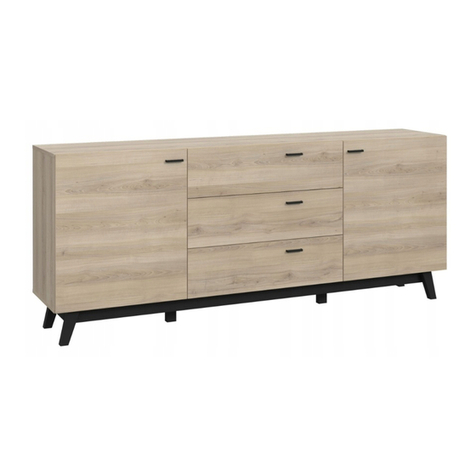
Forte
Forte CERK232 Assembling Instruction

Next
Next BRONX 425622 Assembly instructions
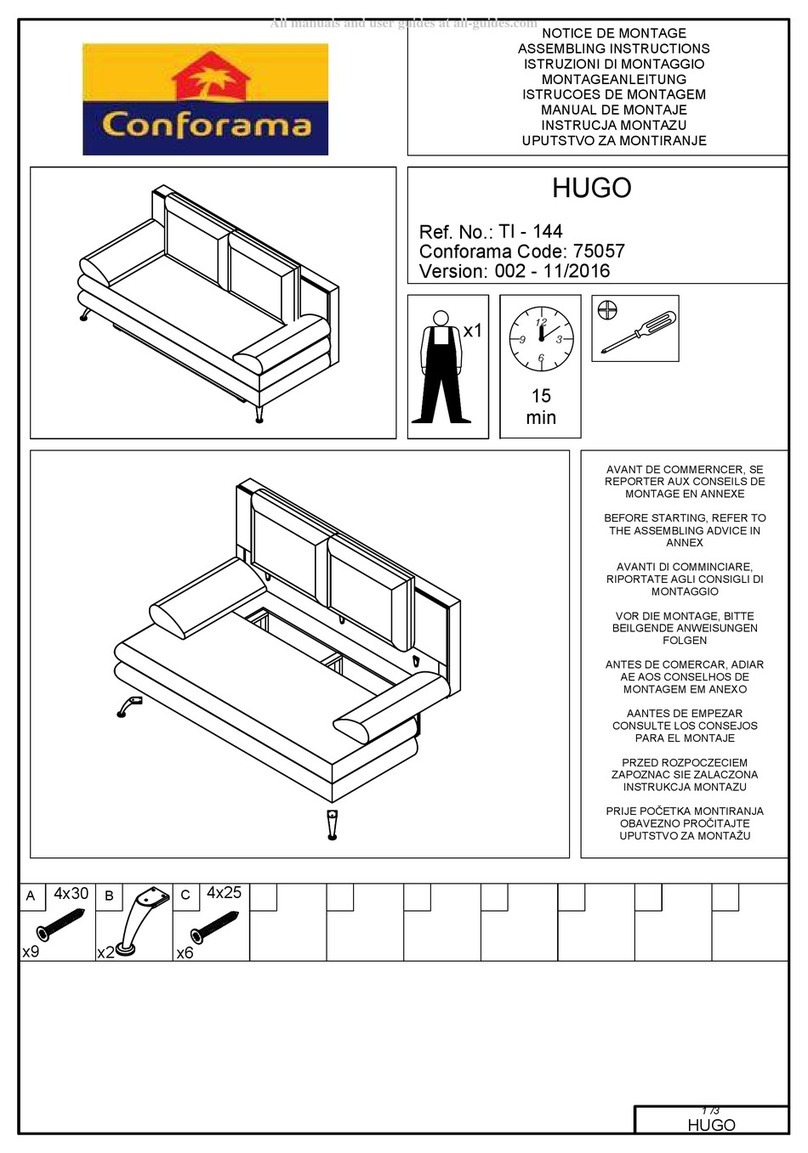
CONFORAMA
CONFORAMA HUGO TI-144 Assembling instructions



